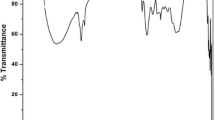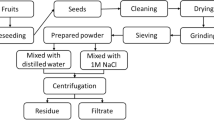Abstract
The coagulation properties of crude extracts and purified proteins of seeds of Moringa stenopetala and tubers of Maerua subcordata, which are locally used for purification of turbid water in Ethiopia, were studied. The turbidity removal effectiveness was compared using synthetic turbid and natural river water where the initial turbidity of synthetic water was approximately 260 NTU, whereas, for river water, the initial turbidity was 30 NTU. The active coagulants from the extracts were purified by the single-step and the two-step ion exchange (IEX) chromatography technique using 0.1, 0.3 and 0.6 M concentrations of NaCl solutions. The protein quantification of a single-step purified active coagulant eluted using 0.6 M showed that the protein content of the M. stenopetala extract was 1016 µg/mL, whereas the concentration of the M. subcordata extract was 700 µg/mL. The dose for coagulation using crude extracts and purified proteins of M. subcordata on surface water was 4 and 2 mg/L, respectively, with 85% of coagulation activity. In the case of M. stenopetala, 14 mg/L dose of crude extracts, which was seven times higher than that of the purified protein, was needed to obtain the desired residual turbidity (5 NTU). The results also indicated that in the two-step purified coagulants, the sludge volume was reduced compared to crude extracts and alum. In conclusion, active coagulants from seeds of M. stenopetala could be scaled up and used in water treatment technology, whereas purifying the extracts from M. subcordata is not required as the crude extracts performed equally well.








Similar content being viewed by others
References
Abatneh Y, Yimer S, Sahu O (2014) Purification of drinking water by low cost method in Ethiopia. Appl Water Sci 4:357–362
Antov MG, Sciban MB, Petrovic NJ (2010) Proteins from common bean (Phaseolus vulgaris) seed as a natural coagulant for potential application in water turbidity removal. Bioresour Technol 101:2167–2172
Baptista ATA, Coldebella PF, Cardines PHF, Gomes RG, Vieira MF, Bergamasco R, Vieira AMS (2015) Coagulation flocculation process with ultrafiltered saline extract of Moringa oleifera for the treatment of surface water. Chem Eng J 276:166–173
Baptista ATA, Silva MO, Gomes RG, Bergamasco R, Vieira MF, Vieira AMS (2017) Protein fractionation of seeds of Moringa oleifera lam and its application in superficial water treatment. Sep Purif Technol 180:114–124
Bodlund I, Kasi S, Pavankumar AR, Sankaran K, Chelliah R, Rajarao GK (2014) Coagulant proteins identified in mustard: a potential water treatment agent. Int J Environ Sci Technol 11:873–880
Bolto B, Gregory J (2007) Organic polyelectrolytes in water treatment. Water Res 41(11):2301–2324
Bondy SC (2014) Prolonged exposure to low levels of aluminium leads to changes associated with brain aging and neuro degeneration. Toxicol 315:1–7
Bradford MM (1976) Rapid and sensitive method for quantitation of microgram quantities of protein utilizing principle of protein-dye binding. Anal Biochem 72:248–254
Camacho FP, Sousa VS, Bergamasco R, Teixeira MR (2017) The use of Moringa oleifera as a natural coagulant in surface water treatment. Chem Eng J 313:226–237
Choy SY, Prasad KMN, Wu TY, Ramanan RN (2015) A review on common vegetables and legumes as promising plant-based natural coagulants in water clarification. Int J Environ Sci Technol 12:367–390
Dhivya S, Ramesh ST, Gandhimathi R, Nidheesh PV (2017) Performance of natural coagulant extracted from Plantago ovata seed for the treatment of turbid water. Water Air Soil Pollut 228:423
Edzwald JK, Tobiason JE (1999) Enhanced coagulation: US requirements and a broader view. Water Sci Technol 40(9):63–70
Ghebremichael K, Gunaratna KR, Henriksson H, Brumer H, Dalhammar G (2005) A simple purification and activity assay of the coagulant protein from Moringa oleifera seed. Water Res 39:2338–2344
Ghebremichael KA, Dalhammar G, Gunaratna KR (2006) Single-step ion exchange purification of the coagulant protein from Moringa oleifera seed. Appl Microbiol Biotechnol 70:526–532
Ghernaout D, Ghernaout Badiaa, Naceur MW (2011) Embodying the chemical water treatment in the green chemistry—a review. Desalination 271:1–10
Kawamura S (1991) Effectiveness of natural polyelectrolytes in water treatment. J Am Water Works Assoc 83:88–91
Lee SH, Lee SO, Jang KL, Lee TH (1995) Microbial flocculant from arcuandedndron sp. 49. Biotechnol Lett 17:95–100
Madrona GS, Branco IG, Seolin VJ, Filho BAA, Fagundes MR, Bergamasco R (2012) Evaluation of extracts of Moringa oleifera Lam seeds obtained with NaCl and their effects on water treatment. Acta Sci Technol 34:289–293
Marobhe NJ (2013) Effectiveness of crude extract and purified protein from Vigna unguiculata seed in purification of Charco dam water for drinking in Tanzania. Int J Environ Sci 4:3
Marobhe NJ, Gunaratna KR (2012) Effect of coagulant protein from Parkinsonia aculeata and Citrus juice on bacteria isolated from Ruvu River in Tanzania. Int J Appl Sci Eng Res 1:714–724
Marobhe NJ, Dalhammar G, Gunaratna KR (2007) Simple and rapid methods for purification and characterization of active coagulants from the seeds of Vigna unguiculata and Parkinsonia aculeata. Environ Technol 28:671–681
Megersa M, Beyene A, Ambelu A, Woldeab B (2014) The use of indigenous plant species for drinking water treatment in developing countries: a review. J Biodivers Environ Sci 5(3):269–281
Megersa M, Beyene A, Ambelu A, Asnake D, Bekele T, Firdissa B, Alebachew Z, Triest L (2016) A preliminary evaluation of locally used plant coagulants for household water treatment. Water Conserv Sci Eng 1(2):95–102
Megersa M, Beyene A, Ambelu A, Triest L (2017) Extraction of natural coagulants from Maerua subcordata and Moringa stenopetala for use in turbid water treatment. Desalin Water Treat 59:127–134
Muthuraman G, Sasikala S (2014) Removal of turbidity from drinking water using natural coagulants. Ind Eng Chem Res 20:1727–1731
Muyibi SA, Evison LM (1995) Optimizing physical parameters affecting coagulation of turbid water with Moringa oleifera seeds. Water Res 29:2689–2695
Ndabigengesere A, Narasiah KS (1998) Quality of water treated by coagulation using Moringa oleifera seeds. Water Res 32(3):781–791
Ndabigengesere A, Narasiah KS, Talbot BG (1995) Active agents and mechanism of coagulation of turbid waters using Moringa oleifera. Water Res 29:703–710
Okuda T, Baes AU, Nishijimam W, Okada M (2001) Isolation and characterization of coagulant extracted from Moringa oleifera seed by salt solution. Water Res 35:405–410
Oladoja NA (2015) Headway on natural polymeric coagulants in water and wastewater treatment operations. J Water Process Eng 6:174–192
Oladoja NA, Saliu TD, Ololade IA, Anthony ET, Bello GA (2017) A new indigenous green option for turbidity removal from aqueous system. Sep Purif Technol 186:166–174
Pritchard M, Mkandawire T, Edmondson A, O’Neill JG, Kululanga G (2009) Potential of using plant extracts for purification of shallow well water in Malawi. Phys Chem Earth 34:799–805
Pritchard M, Edmondson A, Craven T, Mkandawire T (2016) Development of sustainable drinking water quality solutions for rural communities in the developing world. In: Dastbaz M, Gorse C (eds) Sustainable ecological engineering design. Springer, Berlin, pp 259–277
Ramavandi B (2014) Treatment of water turbidity and bacteria by using a coagulant extracted from Plantago ovata. Water Resour Ind 6:36–50
Ramavandi B, Hashemi S, Kafaei R (2015) A novel method for extraction of a proteinous coagulant from Plantago ovata seeds for water treatment purposes. MethodsX 2:278–282
Renault F, Sancey B, Badot PM, Crini G (2009) Chitosan for coagulation/flocculation processes an eco-friendly approach. Eur Polym J 45(5):1337–1348
Ribes D, Colomina MT, Vicens P, Domingo JL (2008) Effects of oral aluminium exposure on behavior and neurogenesis in a transgenic mouse model of Alzheimer’s disease. Exp Neurol 214(2):293–300
Rondeau V, Jacqmin-Gadda H, Commenges D, Helmer C, Dartigues JF (2009) Aluminium and silica in drinking water and the risk of Alzheimer’s disease or cognitive decline: findings from 15-year follow-up of the PAQUID cohort. Am J Epidemiol 169(4):489–496
Sanchez-Martin J, Ghebremichael K, Beltran-Heredia J (2010) Comparison of single-step and two-step purified coagulants from Moringa oleifera seed for turbidity and DOC removal. Bioresour Technol 101:6259–6261
Saranya P, Ramesh ST, Gandhimathi R (2013) Effectiveness of natural coagulants from non-plant-based sources for water and wastewater treatment—a review. Desalin Water Treat 52(31–33):6030–6039
Shannon MA, Bohn PW, Elimelech M, Georgiadis JG, Marinas BJ, Mayes AM (2008) Science and technology for water purification in the coming decades. Nature 452(7185):301–310
Vijayaraghavan G, Sivakumar T, Vimal KA (2011) Application of plant based coagulants for wastewater treatment. Int J Adv Res Technol 1(1):88–92
Wang Z, Wei X, Yang J, Suo J, Chen J, Liu X, Zhao X (2016) Chronic exposure to aluminum and risk of Alzheimer’s disease: a meta-analysis. Neurosci Lett 610:200–206
Yin CY (2010) Emerging usage of plant-based coagulants for water and wastewater treatment. Process Biochem 45:1437–1444
Acknowledgements
The authors are grateful to the Erasmus Mundus action 2, Caribu scholarship of the Vrije Universiteit Brussel; the International Foundation for Science (IFS, W/5406-1); Madawalabu University and Jimma University for financial and logistic support.
Author information
Authors and Affiliations
Corresponding author
Additional information
Editorial responsibility: M. Abbaspour.
Rights and permissions
About this article
Cite this article
Megersa, M., Beyene, A., Ambelu, A. et al. Comparison of purified and crude extracted coagulants from plant species for turbidity removal. Int. J. Environ. Sci. Technol. 16, 2333–2342 (2019). https://doi.org/10.1007/s13762-018-1844-2
Received:
Revised:
Accepted:
Published:
Issue Date:
DOI: https://doi.org/10.1007/s13762-018-1844-2




